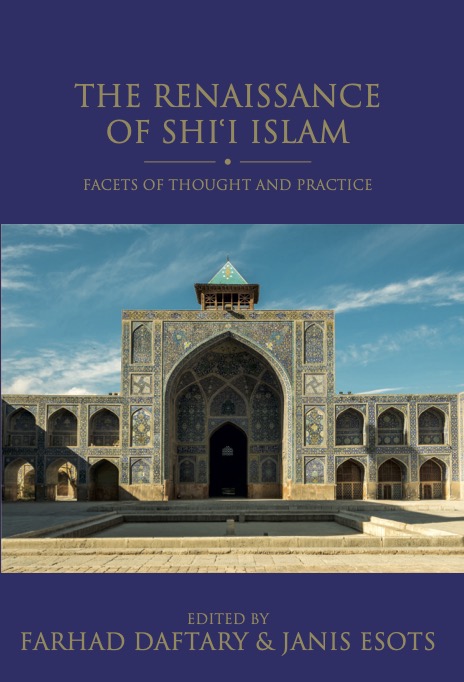This book is also available OPEN ACCESS to download or read online for free.
The renaissance of Shiʿi Islam began in the 9th/15th century when the IsmailisAdherents of a branch of Shi’i Islam that considers Ismail, the eldest son of the Shi’i Imam Jaʿfar al-Ṣādiq (d. 765), as his successor. experienced the Anjudān revival and Twelver Shiʿi traditions were also renewed. This renaissance gained further strength when the SafavidsA major Shi’i dynasty which ruled Persia (1501-1732 CE), and was succeeded by the Afsharids. (See also Qizilbash, Safawiyya.) succeeded in establishing a state in the early decades of the 10th/16th century, making Ithnā ʿasharī Shiʿi Islam their official religion.
Although the political and artistic developments of the Safavid era of the 10th–12th/16th–18th centuries have been extensively studied, the complexities of the different groups, movements and strands of thought in the renaissance of Shiʿi Islam still remain largely unexplored. The chapters in this book represent the most recent scholarship on the intellectual and spiritual life of the age and discuss what prepared the ground for the revival of Shiʿi Islam as well as its achievements. The major themes that characterised the Shiʿi renaissance are explored, including: popular reactions to messianic movements; literary and artistic achievements; the development of legal theories and concepts; the investigation of theological and philosophical problems, above all by the ‘School of Isfahan’; Shiʿi-Sufi interactions and intra-Shiʿi relations; the collection of Shiʿi ḥadīthLit. ‘report’ or ‘narrative,’ used for the traditions of the Prophet Muhammad and in Shi‘i Islam also for those of the Imams. and its application in Shiʿi exegesis; and the interplay between political considerations and religious beliefs.
Contributors
Abbreviations
Preface
Farhad Daftary
1. The Shiʿi Milieu of Post-Mongol Persia
Farhad Daftary
Part One: Ismailism in the Context of Shiʿi-Sufi Coalescence
2. A Reconsideration of Post-Alamūt Nizārī Ismaili Literature in Iran: Prose and Poetry
S.J. Badakhchani
3. The Scent of the Scarlet Pimpernels: Ismaili Leaders of the 11th/17th Century
Shafique N. Virani
4. Ismaili Doctrines in a Late Safavid Work: Quotations from the Risālat al-Jāmiʿa in Quṭb al-Dīn Ashkivarī’s Maḥbūb al-Qulūb
Daniel De Smet
Part Two: Shiʿi Messianism and the Symbolism of Letters
5. The Resurrection of Shah Ismāʿīl in Alevi-Bektashi Literature
Amelia Gallagher
6. Ḥurūfism after Faḍl Allāh’s Execution: Revisiting Ṣaḥīfat al-Istikhlāṣ
Fatih Usluer
7. Nuqṭavīs, Safavids and Shiʿism in the 9th–11th/15th–17th Centuries
Orkhan Mir-Kasimov
Part Three: Ḥadīth and Fiqh
8. Majlisī the Second, Ambiguous Architect of the Shiʿi Revival in Safavid Iran
Mohammad Ali Amir-Moezzi
9. The Akhbārī Movement and Literary Production in Safavid Iran
Devin J. Stewart
10. Postclassical Legal Commentaries: The Elaboration of Tradition in the Twelver Shiʿism of Safavid Times
Robert Gleave
11. A View from the Periphery: The Ijāza as Polemic in Early 10th/16th-Century Twelver Shiʿism
Andrew J. Newman
Part Four: Philosophy, Theology and Intellectual History
12. Mir Damad’s ‘Wisdom of the Right Side’ (al-ḥikma al-yamāniyya)
Janis Esots
13. Some Aspects of the Reception of Suhrawardi’s Philosophy by Mullā Ṣadrā
Christian Jambet
14. A Symphonia of Shiʿism, Philosophy and Sufism from the Late Safavid Period: Quṭb al-Dīn Ashkivarī’s Epistle on the Imaginal World (written in 1077/1667)
Mathieu Terrier
15. Shah Ṭahmāsp’s View of Nature, as Reflected in his Shāhnāma
Sheila R. Canby
Select Bibliography
Farhad Daftary is Co-Director of The Institute of Ismaili Studies, and Head of its Department of Academic Research and Publications. He is a consulting editor of Encyclopaedia Iranica, co-editor of Encyclopaedia Islamica, and has written and edited 25 books in the field of Ismaili studies, including The Ismāʿīlīs: Their History and Doctrines (1990; 2nd ed., 2007); The Assassin Legends (1994); A History of Shiʿi Islam (2013); and The Ismaili Imams: A Biographical History (2021). Farhad Daftary’s books have been translated into Arabic, Persian, Turkish, Urdu, Gujarati and numerous European languages.
Janis Esots was Associate Professor at the Department of Asian Studies, University of Latvia and Research Associate at The Institute of Ismaili Studies (2013–2021). His research focused on Ismaili thought and the philosophical school of Iṣfahān (Mullā Ṣadrā, Mīr Dāmād and Rajab ʿAlī Tabrīzī). He was the managing editor of Encyclopaedia Islamica and the editor of the Islamic Philosophy Yearbook Ishraq. Shortly after his death in 2021, his monograph, Patterns of Wisdom in Safavid Iran: The Philosophical School of Isfahan and the Gnostic of Shiraz was published (2021).

